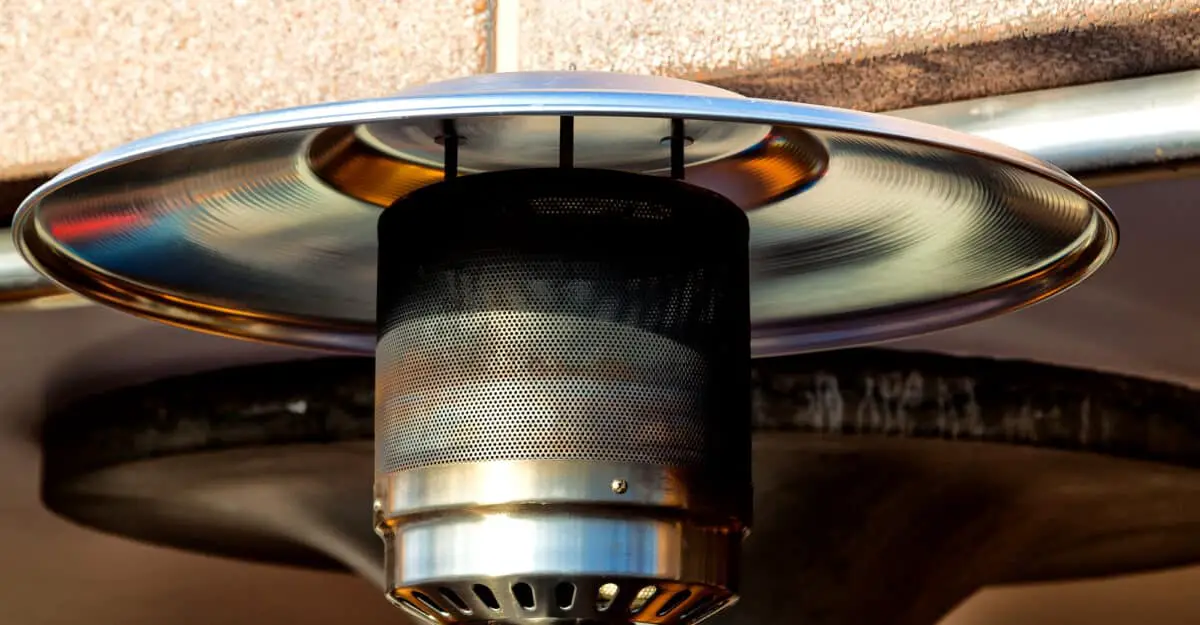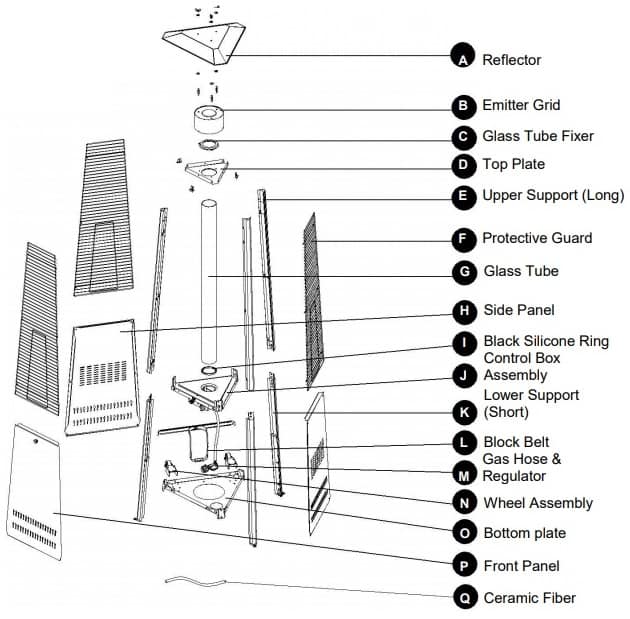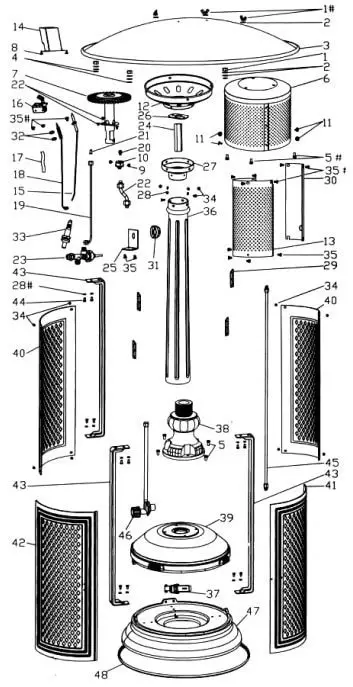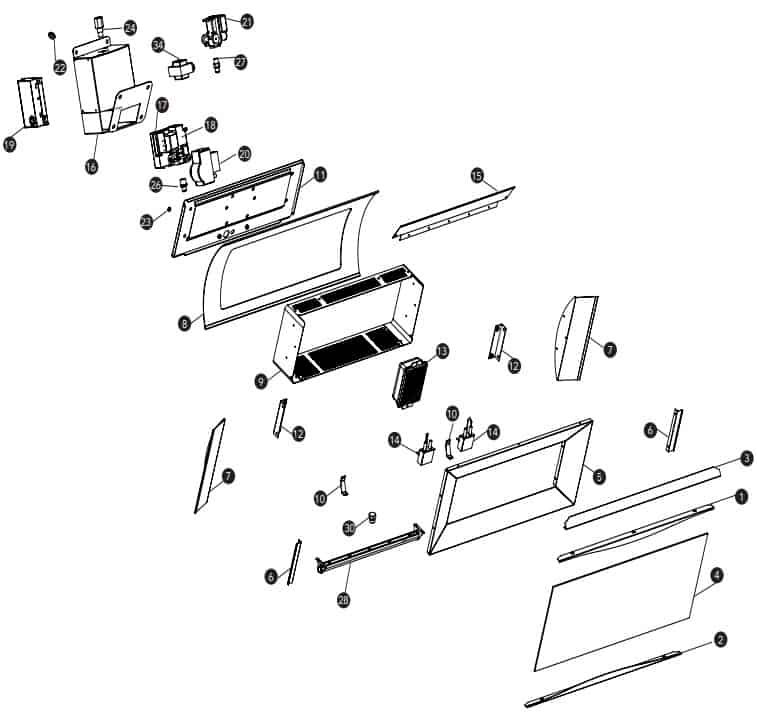Are you looking forward to purchasing a new patio heater? You should know the most common patio heater parts for replacement.
Most Common Patio Heater Parts
- Heater Regulator
- Glass Tube
- THP-Burner
- Thermocouple
- Pilot Assembly
- Thermostat
- Failure Safety Control Valve Kit
- Quick Disconnect Hose Set
- Head Assembly
- Spark Ignition
If you want to enjoy the outdoors even in colder months, consider buying a patio heater to keep you warm and cozy.
You can create a comfortable and relaxing outdoor space on your patio or deck year-round with knowledge of patio heater maintenance.
This will help you to get the most out of your outdoor spaces throughout the year and in the evenings.
When purchasing your first or next patio heater, learning about patio heater parts can help you make an informed decision.
Depending on the type and model of a patio heater, the included parts may vary.
In this post, we will analyze different types of patio heaters, available parts, and common problems.
Related Reading: 10 Common Patio Heater Problems and How to Best Fix Them

National Fire Protection Association: Outdoor Heater Safety Fact Sheet
Table of Contents
Types of Patio Heater Parts
The patio parts that need replacement depend on the make and model of the heater.
This list is a general guide for new patio heater owners.
Here is an example of a patio heater and its seventeen components:

Let’s take a closer look at the ten most common patio heater parts that can need replacing.
Heater Regulator
To maintain a stable and uniform temperature, you need these components for your patio heaters.
Due to the height of many patio heater models, heat regulators for patio heaters require longer hoses.
The hose connects the heater element to the propane tank with a regulator.
Glass Tube
If your patio heater is ever knocked over by wind, this piece is most likely to be damaged.
Glass tubes on patio heaters are popular on modern models. They contain the gas-fueled flame, giving it a straight, vertical appearance.
Burner
Burners on patio heaters ignite the fuel source, usually propane or natural gas.
The burner also helps to direct the flames into a perforated metal screen and then radiate that heat from the screen’s surface.
The heat is radiated in a circular pattern around the patio heater to deliver surround heating.
Thermocouple
When the thermocouple detects heat, it sends a signal to the gas valve to open and allow gas to flow to the burner.
When a patio heater fails to turn on, often a weak or non-functioning pilot is caused by a faulty thermocouple.

Pilot Assembly
The pilot assembly’s function is to maintain the patio heater’s flame by sending an electric signal to the gas valve through a sensor.
It signals the valve to stay open.
Thermostat
A thermostat on a patio heater controls whether the heating is on or off.
It also regulates the flow of the fuel source, propane or natural gas, which in turn helps maintain the overall temperature.
Failure Safety Control Valve Kit
These control how patio heaters will operate when there is a loss of power or signal. This helps protect the patio heater, typically in emergencies.
If the fuel source is lost during your patio heater operation, the safety control valve will turn off the pilot light.
When issues arrive with safety control valves, you’ll notice your patio heater turning off even with a steady flame.
Regulator Hose Set
These are the hoses that connect your propane tank to the patio heater.
While they are typically made to last, outdoor small animals can cause damage or they can become damaged accidentally.
Wear and tear over time can also cause these hoses to lose their airtight connection causing the fuel source to leak.
Pilot Feed Tube
Pilot feed tubes connect your pilot flame to the central control valve. Issues with these will cause problems with the pilot light that can lead to an inability to start the patio heater.
These tubes can become clogged or broken over time but are fairly easy to repair or replace.
Spark Ignition
These ignite the pilot light to allow the fuel to catch and begin burning at the desired intensity.
Issues with spark ignitions will cause difficulty in getting your patio heater started.
Depending on the model, there may be manual ways around this, such as using a BBQ lighter. However, sometimes, the model depends on the spark ignition solely.

The Different Types of Patio Heaters
Freestanding Patio Heaters
When looking at available patio heaters, freestanding models are popular.
Freestanding heaters deliver a great experience and are pretty straightforward to use.
In most instances, we don’t want to install a patio heater permanently.
Being able to easily move a patio heater based on weather and upgrading it later is convenient.
We recommend purchasing a freestanding patio heater for added versatility.
You won’t need to use any mounting brackets to secure the patio heater and start using it.
They bring along portable propane tanks to provide you with the desired functionality.
The freestanding patio heaters you purchase will contain their controls.
You can take better control over the heater according to your preferences.
There are four distinct types of freestanding patio heaters available for purchase to use in outdoor settings.
Quartz Tube-Type Patio Heaters
If you want to elevate the appearance of your outdoor space, choose these patio heaters. They can create the perfect ambiance.
They are also an excellent option for smaller spaces.
However, patio heaters are not very efficient and do not perform well in strong winds.
Mushroom-Type Patio Heaters
The mushroom-type patio heaters come in various sizes and add an aesthetically pleasing look to your outdoor space.
These are the perfect options available for any small space.
However, the mushroom-type patio heaters are not the most efficient and they only provide little resistance against wind.
Bromic Tungsten Smart-Heat Patio Heaters
These patio heaters are equipped with advanced features and parts, giving them a modern and chic appearance.
These patio heaters offer the most efficient option and excellent wind resistance. You can get directional heating out of them with minimum trouble.
In order to purchase this type of patio heater, a substantial amount of money will need to be spent.
Table-Style Patio Heaters
If you have enough space, consider purchasing a table-style patio heater.
Table-style patio heaters have a modern design and come equipped with a safety cutoff feature. These patio heaters can be used as tables when not in use.
This patio heater provides useful table space but does not heat the upper air. They are not the most wind-resistant and efficient patio heaters you can buy.
Wall-Mounted Patio Heaters
A wall-mounted patio heater is ideal for saving space, in addition to freestanding ones. Mounting the patio heater away from traffic creates more outdoor space.
Wall-mounted patio heaters are the most efficient and provide better control options. It is possible to have a less intrusive experience with them.
You should be aware that wall-mounted patio heaters come at a higher cost compared to other options.
However, the returns justify the expense, even though it means giving up portability.
If you don’t have any plans to move the patio heater, you can go ahead with this option.
Remember to review the patio heater parts with any style for future repair costs.
Different Materials Used for the Manufacturing of Patio Heaters
Manufacturing materials commonly used for patio heaters.
Coated Stainless Steel
Stainless steel patio heaters are durable and weather-resistant, but their coating can be easily scratched or damaged. They are available in various color options.
Stainless Steel
If you’re looking for sleek and professional patio heaters, check these out.
Stainless steel patio heaters have a sleek and professional design that is also weather-resistant.
It is not recommended to use this type of patio heater in coastal environments.
Aluminum
The aluminum patio heaters can deliver additional corrosion resistance compared to other patio heaters you can purchase. However, these are less durable.
You can browse through various options and select the best heater with matching patio heater parts to suit your specific needs.
Final Notes
Some patio heater parts may need replacing; this list covers the most common ones..
Whether it’s an accident or wear and tear, appliances don’t last forever.
If there is a professional in your area, it can be worth being proactive and having your patio heater inspected during the off-season to prepare for future use.
You can ensure quick recovery from a broken patio heater part by keeping frequently replaced parts like the glass tube on hand.
If you don’t want to keep spare parts on hand, it’s easy enough to purchase replacement parts online from stores like Amazon.
Enjoy living the outdoor life!
Continue Reading:
